
 |
Tea Clipper |
 |
| from TeaAntiques.com | ||
| Edition Eighty Three |
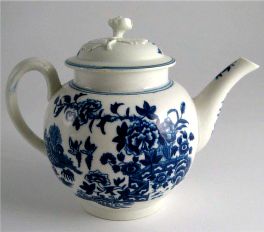 A
delightful First Period Worcester teapot and cover, decorated in blue and white
with the charming 'fence' pattern. This beautiful teapot and cover are of a pleasing
shape and the lid is surmounted with a flower finial, c1770 and is a very fine example
of Worcester's high quality blue and white printed decoration wares. This teapot
and cover in particular are in exceptionally good condition.
A
delightful First Period Worcester teapot and cover, decorated in blue and white
with the charming 'fence' pattern. This beautiful teapot and cover are of a pleasing
shape and the lid is surmounted with a flower finial, c1770 and is a very fine example
of Worcester's high quality blue and white printed decoration wares. This teapot
and cover in particular are in exceptionally good condition.
The teapot has the fence pattern in blue on both sides of its body. The 'Fence Pattern', as this pattern is known, was a popular one at the Worcester factory and gets its name from the fence which appears in the main print of the pattern. The fence is surrounded by pretty flowers and foliage. This decoration is very crisp and beautifully detailed. The fence pattern is also applied to the teapot's cover. The delicate flower finial to the cover is in absolutely excellent condition, which is very rare to find.
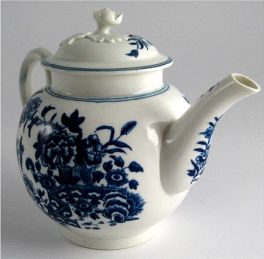
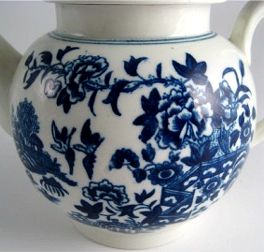
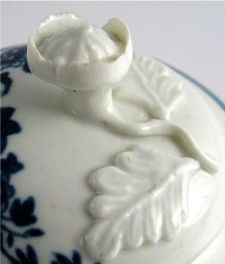
The underside of the teapot is marked with the Worcester underglaze blue crescent mark. The blue crescent mark was used at the Worcester factory c1755-90. This very fine teapot and cover would have been made at this factory c1770.
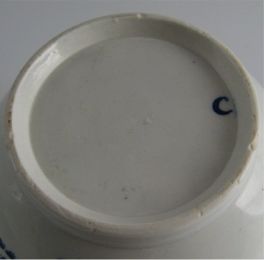
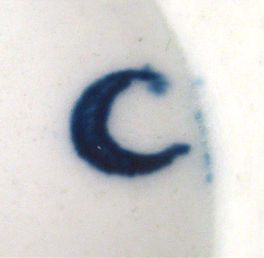
More details of this item and other tea related antiques can be found by visiting my web site at www.TeaAntiques.com.
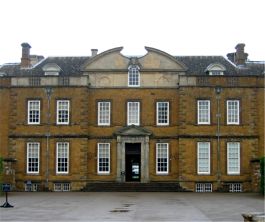 Upton
House is perhaps best known for its breathtaking collection of art. However, as
I was to discover on my visit to the house and gardens, it not only houses this
priceless art collection, but also has a very fine collection of porcelain from
the eighteenth century. A collection which includes, Worcester, Chelsea and Sèvres
in abundance, including some exquisite tea wares.
Upton
House is perhaps best known for its breathtaking collection of art. However, as
I was to discover on my visit to the house and gardens, it not only houses this
priceless art collection, but also has a very fine collection of porcelain from
the eighteenth century. A collection which includes, Worcester, Chelsea and Sèvres
in abundance, including some exquisite tea wares.Upton House we see today has its roots back to the late seventeenth century, but it was in 1927 that it became the country home of Walter Samuel, 2nd Viscount Bearsted. He was an oil magnet and philanthropist who had collected together one of the finest collections of art to be seen in the 20th century. He inherited from his father a fine collection of art, especially eighteenth century English portraits and Dutch paintings, to which he then added his own collection which included some very fine rural life paintings by George Stubbs.
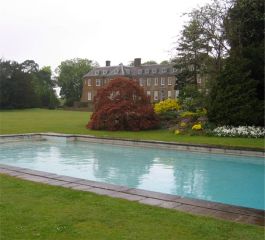
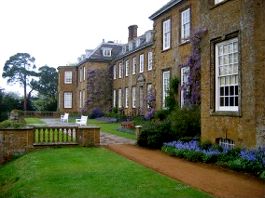
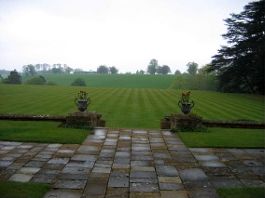
Walter had the old seventeenth century house totally remodelled over the next
21 years, particularly inside to fashion it into a comfortable Edwardian country
home in which to display his collections. As well as the changes to the house, he
remodelled the garden, which was an awkward deep sloping site. This he has done
to great effect.
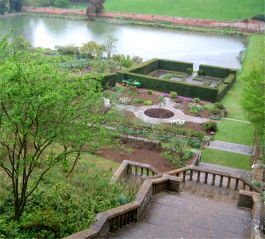 From
the house there is an extensive flat lawn stretching away to a wall and swimming
pool. The view, which is uninterrupted lawn to the hills on which sheep can be seen
grazing, hides completely the garden that is configured out of sight on the steep
slopes. Walking across the lawn away from the house, you are certainly taken by
surprise when you reach the concealed wall, for laying out before you is a very
large walled and terraced garden in which there is a large vegetable and fruit garden
and beyond a rectangular mirror pond.
From
the house there is an extensive flat lawn stretching away to a wall and swimming
pool. The view, which is uninterrupted lawn to the hills on which sheep can be seen
grazing, hides completely the garden that is configured out of sight on the steep
slopes. Walking across the lawn away from the house, you are certainly taken by
surprise when you reach the concealed wall, for laying out before you is a very
large walled and terraced garden in which there is a large vegetable and fruit garden
and beyond a rectangular mirror pond.
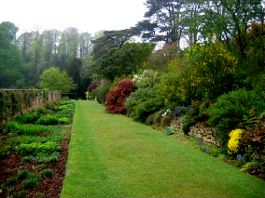 Navigating
your way down the terraces and steps seems a bit precarious in places, but provides
good birds eye views and vistas along the terraces. Along the top terraces are long
herbaceous borders and rockeries, this giving way below to the working kitchen garden
which provided the fruit and vegetable for the house.
Navigating
your way down the terraces and steps seems a bit precarious in places, but provides
good birds eye views and vistas along the terraces. Along the top terraces are long
herbaceous borders and rockeries, this giving way below to the working kitchen garden
which provided the fruit and vegetable for the house.
Reaching the bottom of the garden where the mirror pond is situated, walking round the far side of the pond and looking back at the sloping garden, all that can be seen of the house is the tip of the chimney pots! The house is as concealed from the bottom of the garden as the garden is from the house.
There is a further low garden to the side of the house and its vast lawn. This area is the bog garden which is pretty in its formation of twisting paths and man made streams together with its planting. A delightful small red brick cottage aptly called 'bog cottage' is situated to the end of this area of garden. This cottage was originally the late seventeenth century banqueting house.
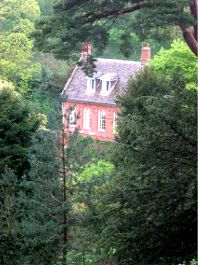
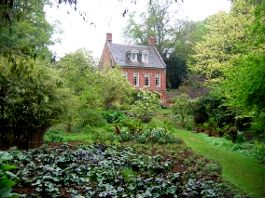
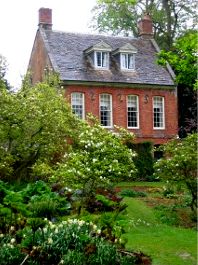
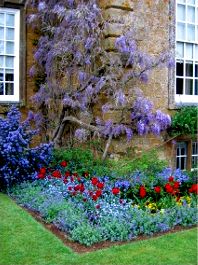 From
the bog garden, there is a zigzag path leading back up to the level lawn in front
of the main house. A walk along the front of the house, one can admire the formally
planted beds, and in May, the Wisteria growing up the house is in bloom producing
a powerful scent.
From
the bog garden, there is a zigzag path leading back up to the level lawn in front
of the main house. A walk along the front of the house, one can admire the formally
planted beds, and in May, the Wisteria growing up the house is in bloom producing
a powerful scent.
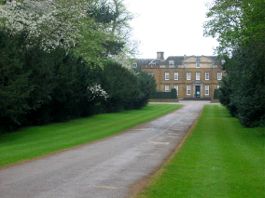 The
entrance to the house is on the other side to this lawn side. This in fact is the
first side you see of the house as you approach it down a long drive, with lawn
and tress on each side framing the house.
The
entrance to the house is on the other side to this lawn side. This in fact is the
first side you see of the house as you approach it down a long drive, with lawn
and tress on each side framing the house.
Entering the house you find yourself in the Entrance Hall. This whist being totally remodelled from the 1927 makeover, it still contains a very fine William Kent style marble chimneypiece. On the walls of the hall are some of a set of Brussels tapestries woven in wool and silk, these dating from the mid seventeenth century.
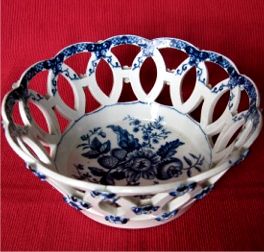 In
the dining room of the house, I was amazed to see so many first (Dr Wall) period
items of porcelain. On the table there were about seven pierced baskets c1765, in
blue and white of various forms, from oval with twisted handles, to circular without
handles, decorated in blue 'flower and pinecone' pattern. These made a beautiful
display together with matching period Worcester plates with the same flower and
pinecone pattern. the circular basket shown here, is similar to those on the dining
table. On a serving table at the end of the dining room were a pair of very handsome
chestnut baskets or tureens each with their stands. Also, on a small mahogany sideboard
are a set of Worcester blue and white vases c1765-70.
In
the dining room of the house, I was amazed to see so many first (Dr Wall) period
items of porcelain. On the table there were about seven pierced baskets c1765, in
blue and white of various forms, from oval with twisted handles, to circular without
handles, decorated in blue 'flower and pinecone' pattern. These made a beautiful
display together with matching period Worcester plates with the same flower and
pinecone pattern. the circular basket shown here, is similar to those on the dining
table. On a serving table at the end of the dining room were a pair of very handsome
chestnut baskets or tureens each with their stands. Also, on a small mahogany sideboard
are a set of Worcester blue and white vases c1765-70.
Moving on into the long gallery there are some glass fronted cabinets in the
walls that contain some more exquisite early pieces of English porcelain, many are
Chelsea figures from the mid-eighteenth century. This long gallery was created from
the alterations in 1927-9, when a series of smaller rooms were knocked into one
room. For those who enjoy art, the room is mainly filled with Dutch 17th century
paintings. However, for me the delight of this room, was the early English porcelain.
There are four cabinets along the wall of the room in which are pieces from the
Chelsea, Derby, Worcester and Liverpool factories.
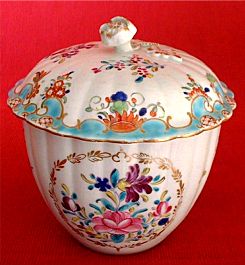 Many
of the pieces are of figures. However, in one cabinet there are two pieces from
a Worcester tea service. There is a Sucrier and cover (similar in shape to that
shown) and matching cake plate are beautifully decorated. they have vertical fluted
moulded bodies that are very richly decorated in underglaze dark blue and turquoise
with exquisite floral painted decoration in polychrome and very finely applied gilding.
the Sucrier has a flower finial and both have a cartouche with script initials of
the owner of the set for whom it had been commissioned, c1770.
Many
of the pieces are of figures. However, in one cabinet there are two pieces from
a Worcester tea service. There is a Sucrier and cover (similar in shape to that
shown) and matching cake plate are beautifully decorated. they have vertical fluted
moulded bodies that are very richly decorated in underglaze dark blue and turquoise
with exquisite floral painted decoration in polychrome and very finely applied gilding.
the Sucrier has a flower finial and both have a cartouche with script initials of
the owner of the set for whom it had been commissioned, c1770.
There is a room in the house is called the 'Porcelain Lobby', in which there are several glass fronted cabinets full of the most beautiful Sèvres porcelain from the mid to late 18th century. There are some fine examples of decorative tea wares.
In the Picture Room is a glass cabinet in which stand a garniture of seven magnificent
Chelsea 'gold anchor' vases, known as the Dudley vases.
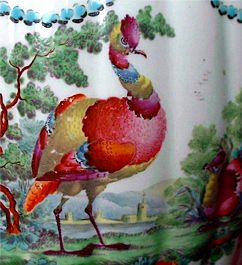 This
stunning set in rococo form have a rich claret ground with exotic birds painted
in enamels on one side and on the other are painted classical nudes. (Note the fancy
birds shown here are from a Worcester teapot). They were made at the Chelsea factory
in 1767 and are said to have been ordered by King George III as a wedding gift to
Lady Cope in 1767. In the nineteenth century they were in the possession of Lord
Dudley and hence known as the Dudley vases.
This
stunning set in rococo form have a rich claret ground with exotic birds painted
in enamels on one side and on the other are painted classical nudes. (Note the fancy
birds shown here are from a Worcester teapot). They were made at the Chelsea factory
in 1767 and are said to have been ordered by King George III as a wedding gift to
Lady Cope in 1767. In the nineteenth century they were in the possession of Lord
Dudley and hence known as the Dudley vases.
At the top landing of the west Stairs is a cabinet in which can be seen one of the largest pieces of porcelain produced at the Chelsea factory. It is a huge figure of 'Una and the Lion' c1765 and is staggering. Una was one of the heroines in Edmund Spenser's poem 'The Faerie Queene', whose virtue was protected by the fearsome lion. Also on this landing are a few cabinets of more early English wares, including some delightful tea wares. There is a part tea Chelsea Derby tea service with a scale pattern in Italian turquoise c1770. Also, a most beautiful Chelsea part tea service with a radiating pattern with gilt trellis design on azureen blue ground alternating with fancy and exotic birds c1760. The teapot of this set is particularly charming, having a pierced rococo handle and also a scroll piercing on the underside of the spout, which is most unusual. Finally, a set that is quite rare, a Chelsea yellow ground part tea service with reserved panels painted with Chinese figures in purple tone, the panels edged with burnished gold decoration, c1760.
Other treats to be experienced in the house is an Art Deco bathroom. This very stylish room was created in the 1920's by Morley Holder for Lady Bearsted. The style is in complete contrast to much of the rest of the house. It has red pillars and window surrounds and walls that are covered in aluminium squares, which at this time was more expensive than silver leaf. Also, the silver leaf would tarnish, whereas the aluminium does not. There are similarly decorated bathrooms at the Savoy Hotel in London, but they went for the cheaper silver leaf!
Before leaving the house there is an exhibition room known as the 'Shell exhibition' and relates to the Shell oil company in the 1930's. The reason it was called the Shell company is that its founder started off business selling boxes, such as trinket boxes, that were decorated with stuck on shells. There are many of the now famous Shell posters on display in this exhibition.
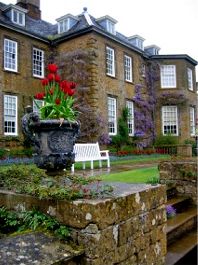
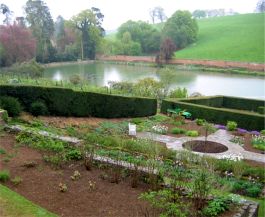
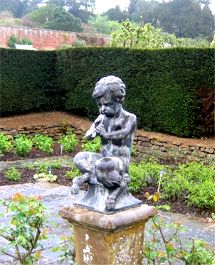
This is certainly an interesting house to visit if you like early English and French Sèvres porcelain, as there are some very fine pieces to be seen including many tea related items. Also, the collection of art is magnificent and there are special tours of the art if you would like one. Finally, the gardens are interesting in the use of the steep sloping valley to the back and side of the house. I hope that you may enjoy a visit to this house.
Upton House and Gardens
Nr Banbury
Warwickshire
OX15 6HT
tel: 01743 708139
www.nationaltrust.org
Local map:
click here
Maps courtesy of www.streetmap.co.uk
To review past newsletters, just follow this link:
Past newsletters.
To subscribe to this free newsletter -
Click here